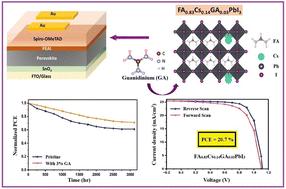经胍改性的无ma三阳离子钙钛矿太阳能电池的光电性能增强
IF 9.5
2区 材料科学
Q1 CHEMISTRY, PHYSICAL
引用次数: 0
摘要
基于卤化物钙钛矿(HHP)的混合太阳能电池以其卓越的光伏性能和作为低成本太阳能技术的潜力彻底改变了光伏景观。在此,我们展示了使用胍离子(GA+)作为掺杂剂来调整混合阳离子钙钛矿,甲咪酰胺-铯三碘化铅(FA0.83Cs0.17PbI3)的性质,以提高钙钛矿太阳能电池(PSCs)的光伏性能。x射线衍射(XRD)结果表明,GA含量对钙钛矿结构中α相和δ相的形成起关键作用。我们的研究结果表明,低/高浓度的GA提高/降低了器件性能。冠军PSC器件在一次阳光照射下具有令人难以置信的20.7%的功率转换效率(PCE)和令人印象深刻的1.12 V开路电压(Voc),以及3% GA+掺杂的最佳含量,这对于无ma器件来说是显着的。此外,与FA-Cs相比,ga掺入的钙钛矿薄膜表现出更好的水分和热稳定性,并增加了载流子寿命。这项工作强调了ga掺杂FA-Cs钙钛矿在开发高性能、稳定和无ma的PSCs方面的潜力,为其在商业光伏技术中的应用铺平了道路。本文章由计算机程序翻译,如有差异,请以英文原文为准。

Enhanced photovoltaic performance in MA-free triple-cation-based perovskite solar cells with guanidinium modification
Hybrid halide perovskite (HHP)-based solar cells have revolutionized the photovoltaic landscape with their exceptional photovoltaic performance and potential as a low-cost solar technology. Herein, we demonstrate the use of guanidinium cation (GA+) as a dopant to tailor the properties of the mixed cation perovskite, formamidinium–cesium lead triiodide (FA0.83Cs0.17PbI3), for improved photovoltaic performance in perovskite solar cells (PSCs). X-ray diffraction (XRD) results reveal that the GA content plays a pivotal role in the formation of α and δ phases in the resultant perovskite structure. Our results indicate that the low/high concentration of GA improves/diminishes device performance. The champion PSC device demonstrates an incredible power conversion efficiency (PCE) of 20.7% and an impressive open-circuit voltage (Voc) of 1.12 V under one sun illumination and an optimal content of 3% GA+ dopant, which is remarkable for an MA-free device. Furthermore, the GA-incorporated perovskite films show much improved moisture and thermal stabilities and increased carrier lifetimes compared with FA–Cs counterparts. This work underscores the potential of GA-doped FA–Cs perovskites in the development of high-performance, stable, and MA-free PSCs, paving the way for their applications in commercial photovoltaic technologies.
求助全文
通过发布文献求助,成功后即可免费获取论文全文。
去求助
来源期刊

Journal of Materials Chemistry A
CHEMISTRY, PHYSICAL-ENERGY & FUELS
CiteScore
19.50
自引率
5.00%
发文量
1892
审稿时长
1.5 months
期刊介绍:
The Journal of Materials Chemistry A, B & C covers a wide range of high-quality studies in the field of materials chemistry, with each section focusing on specific applications of the materials studied. Journal of Materials Chemistry A emphasizes applications in energy and sustainability, including topics such as artificial photosynthesis, batteries, and fuel cells. Journal of Materials Chemistry B focuses on applications in biology and medicine, while Journal of Materials Chemistry C covers applications in optical, magnetic, and electronic devices. Example topic areas within the scope of Journal of Materials Chemistry A include catalysis, green/sustainable materials, sensors, and water treatment, among others.
 求助内容:
求助内容: 应助结果提醒方式:
应助结果提醒方式:


